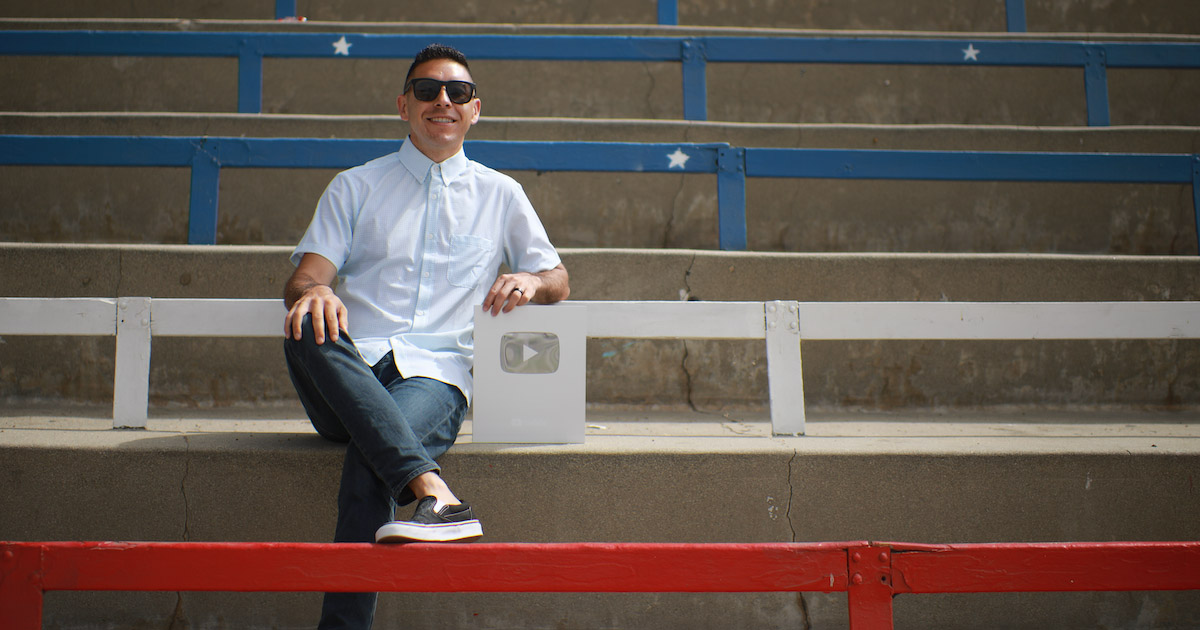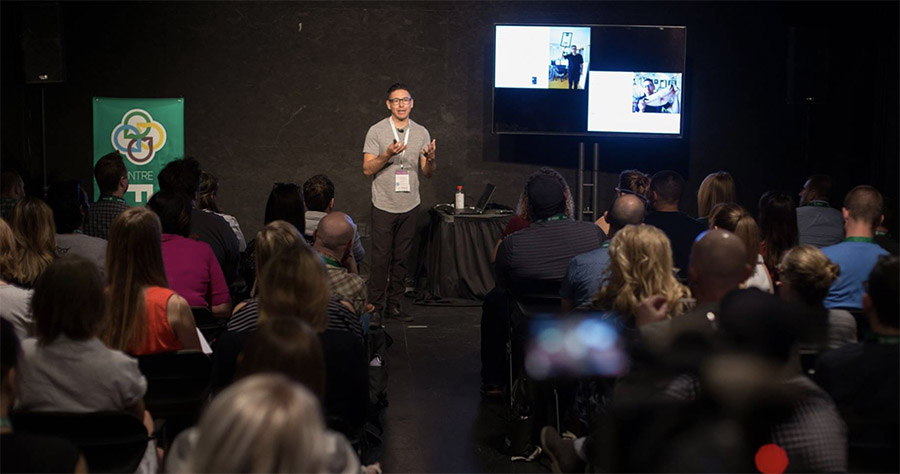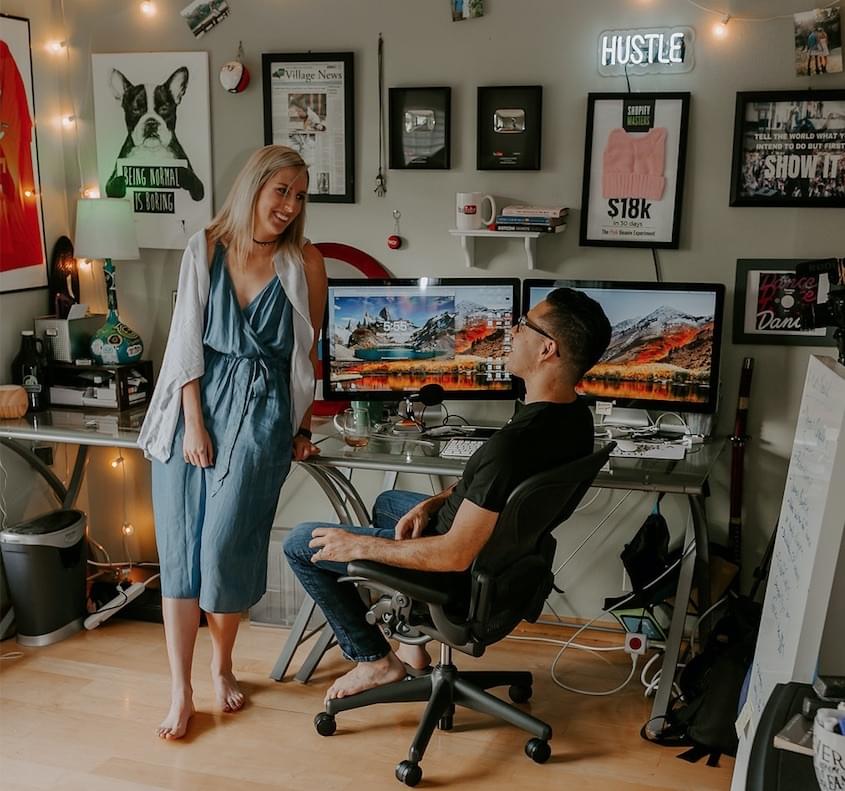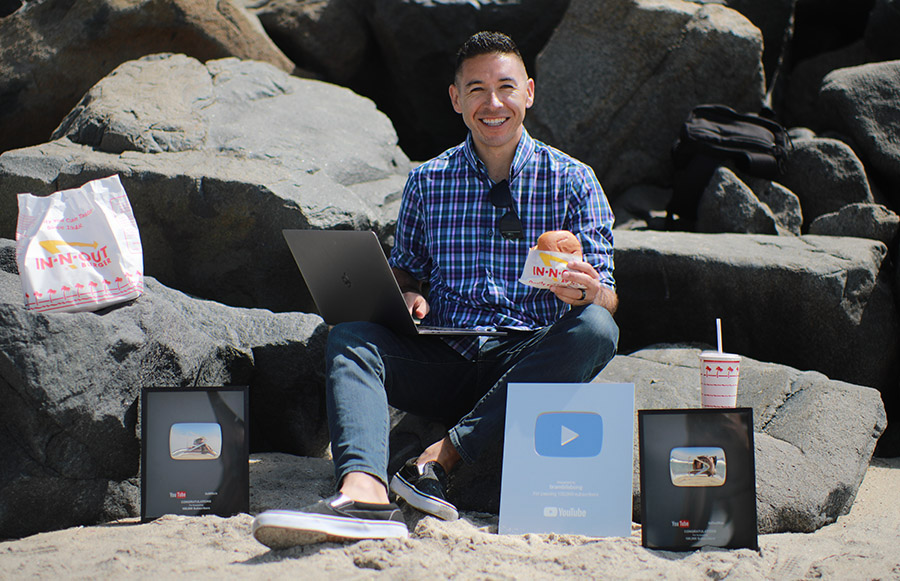
Dance World
Dance used to be rigid and gymnastic, a stringing together of pre-chosen 8-count steps that most people only ever saw once or twice a year, during a halftime show or on MTV. This was how most dancers danced, rehearsing and repeating, trying not to mess up choreography, fully concentrated on counting beats, ignoring the audience until the applause at the end.
Then something changed, a living culture appeared around Hip Hop, and with it emerged a dance that dances back, a philosophy of freestyle that reads and acknowledges the crowd. A popping and locking improvisation of deconstructed rules and reinterpreted moves, building and holding and releasing the energy of arms and heads and legs and torsos. Unique and familiar every single time.
That’s how Adrian Brambila dances. Freestyle popping, easily accessible online, instructing subscribers all over the world from one of his many #1-rated instructional YouTube channels. He knows the tune, he reads the room, he analyzes the tempo and calculates the drop. Unique and familiar every single time.
“Freestyle is the epitome of individual expression, you can’t bring a prepared routine. Choreography is completely different. It’s precise, it’s memorized, it’s a challenge to remain synced up with the music.”
“In college after the first semester I realized how wrong it was for my parents to work their whole lives to give me this opportunity while I just partied. So I stopped, and in my spare time on weekends I committed myself to learning new skills. I tried playing guitar, tried singing, dancing. While the rest of campus was raging every weekend, I was watching YouTube tutorials in an empty gym.”
After six months learning from scratch, cajoling his girlfriend into holding the video camera while he broke down his own moves online, a dance competition in distant Wisconsin popped up. A dance battle. Something the Hip-Hop Heads in the audience call ‘a jam’.
“B-Boys vs. B-Boys, Breakdancers vs. Breakdancers and Poppers vs. Poppers. All in a dance-off against each other, in their own style. The music plays on the spot and you have to listen, you have to be aware of your surroundings and you have to engage with the crowd,” Adrian says.
And for the young man originally from San Diego, a college freshman transplant in Iowa, where he played intercollegiate soccer on the starting line up, the Wisconsin crowd roared its approval and changed his life.
“There’s three audiences you dance for at a jam. Your competitor is first, the person you’re up against, and you have to engage with him and keep up a pose of intimidation. Then there’s the judges, and you don’t want your back to get turned to them ever, they need to see your face always, see what you are feeling. There’s no ability to think about anything else,” Adrian says.
“And then there’s the crowd. They’re paying the closest attention, laughing, whooping and stomping. They are the most powerful force out there, and you have to make them react.”
Marketing World
Marketing used to be rigid and ordered. Long roundtable brainstorm sessions, gut-checking and guessing, creatives working on the rollout, designers kerning the fonts in cornflower blue. Ad campaigns stuck to a 50/50 rule that half of what got put out there would be successful and the other half would fail, but nobody quite knew beforehand which was which.
Then something changed. Internet data showed how defined populations within targeted audiences would behave when certain ad elements were different. Data compiled into files and categories became statistically relevant by its relative ratio to all other accumulated customer information. It showed marketers exactly what worked and exactly what didn’t.
Highly simplified, if more visitors clicked on a green background than a purple background, and if even more clicked when the background was black and the words were silver, then this was a formula to prove ROI. Designers could still kern and style and creatives could still rollout, but the 50/50 just wasn’t true any more. The power of knowing took the guesswork out of marketing.
That’s how Adrian Brambila works. Search engine marketing, transparent explanations in easy-to-watch online videos, guiding multi-billion dollar B2B and B2C clients into precise contact with customers. Constructing the necessary website infrastructure and then interpreting the collected data to feed back into and improve the designated campaign. Unique and familiar every single time.
“Infrastructure means adding up the right technology and the right analytics. By taking website visitor data and sending it back to ads and platforms, we leverage data instead of guess and we sculpt a narrative from the analytics. And 95% of the internet is run on Google Analytics,” Adrian says.
“Tracking isn’t some scary thing to be feared. It gives us the power of knowledge, and knowing something takes the guesswork out of it.”
“Most people who have a Google Analytics dashboard don’t have it set up correctly to track their data. I’ve never seen a single website with all of the necessary infrastructure already in place, from anybody, ” Adrian says.
Hip Hop Hooray
Adrian’s college path changed course after Wisconsin. Partying left the picture completely, soccer lost its priority, and he started a new season on the bench while choosing to spend his energy elsewhere.
Dance on the other hand came to inhabit his every waking step, building into a circle of online friends, collaborators and peers and an audience of family, subscribers and followers.
“Well, my mom was my only follower for a long time,” he says. “Far and away my mom and dad are absolutely my biggest heroes. Their life story is the ultimate American dream. My mom worked up from her first job at a grocery store via community college and then raised me and my sister, paid off and remodeled what is now a full-on Fallbrook, California dream house and then worked for 20 years to become a veteran Data Analyst at the nuclear power plant.”
“My dad’s family had to leave Mexico when he was 17 just to survive. Danger and scarcity at home made a certain kind of truth self-evident to him, that if he had to take whatever work he could get to survive, he was going to do it as he saw fit.”
“My dad had his own side hustles, after he learned english and he got a job washing cars at a Toyota dealership. Talking to people constantly, asking, learning, working to understand this new place, these new people, this new dream. In 2019 I hired him full time and now he’s my business manager, overseeing the 200-plus companies I’m an affiliate for. But he tells me his stories and I’m surprised every time at what he was up to when we were young. The other day he told me he was flipping cars, driving five or six hours and buying beaters or old people sedans and driving them back to sell them for the tiniest margins, flipping them for $100 profit as a side hustle. He stayed at the Toyota dealership for 30 years, worked up to run the parts department, his own $5 million annual operation all inclusive of ordering, forecasting, knowing the changes from back at the factories, what replacement part from another model works in a pinch.”
“They both worked hard to put me and my sister through college, and they gave me this gift of a debt-free chance at life after graduation, and I knew those were things they had earned. And my parents raised us in a household where you earned things.”
So in his Sophomore year in Dubuque, dance now having fully replaced all but academics, Adrian plugged into the wider online community and found an open audition call from Hip-Hop’s savviest live act in search of a diverse and explosive dance crew for his upcoming concert tour.
T-Pain, Tallahassee Pain. The shortened hypocorism, the diminutive Hip Hop metonym of Faheem Rasheed Najm, Florida-born two-time Grammy winner, auto-tune pioneer, app developer and all-round entrepreneur, who from 2006-2010 made an astounding 50 appearances in Top-10 selling singles, either as a principal or a guest.
“When T-Pain announced he was looking for dancers for his national tour, it was an open video audition, and there were thousands of submissions,” Adrian says.
With his girlfriend Ashley again holding the camera, helping him find angles and proper lighting and framing all the shots, Adrian sent his edited submission in among the thousands. Weighing his chances, choosing to act on a dream, Adrian folded up his hoped-for fortune and wished it upon T-Pain’s star. He edited and posted and delivered a dazzling demo reel. He sat down to wait.
He made the Final 30. He spent more time waiting to hear back, searching and watching what the other 29 had at one time or another posted or been tagged in. T-Pain bought him a plane ticket and he flew out to the second half of the audition.
“The whole flight out there for me was so nervous because I didn’t expect to make it, because I’m a living room dancer, not a professional. And I did enough research to believe that at the audition I was going to be learning and repeating 8-count steps the whole time, and other people’s choreography is something I struggle with.”
Day one and the first ten were cut before the end of the afternoon, sent home without even checking into a hotel. Day two and they were down to 20. The creative production team leaned in to size up the candidates. Adrian said everyone was overwhelmed, enthusiastic and in awe of each other’s talent. There was, he said, no jealous ambition, no ego at all.
“They cut 10 more and I was honestly beyond happy at what I had seen already. That would have been enough for me at the time, but then they announced on day two it was a freestyle dance-off, I could see the panic on other people’s faces, and I knew I had a shot.”
On the morning of the third day Adrian thought he was likely headed home, and found heartwarming strength at breakfast when rising from the table to say farewell and congratulate the rest of the auditioners. The audition call started, the dancers lined up on stage to face off, the freestyle jam began. But instead of announcing the final cuts, T-Pain surprised everyone and hired all ten as his back-up crew for the upcoming tour.
“I was so happy I called my girlfriend in tears because I had fully expected to be cut. I did it, against all odds, a YouTube dancer to Hip Hop’s King Midas. Dream. Come. True.”
Adrian’s next phone call brought him right back to reality.
“My parents, they were happy for me, too. They knew it was a dream come true, but they wanted to know if this meant I would miss college. Their dream. My dream, too. It was what they had worked their whole lives towards, and I was still a student, and they were still paying for it.”
A nervous choice, a terrible pressure to make the correct decision and an enormous amount of stress was all avoided when a college mentor whom Adrian had come to rely on for a practical view of the world-at-large helped set up an accredited online class schedule for his upcoming semester. Adrian could stay in school and rock the house as well.

T-Pain put Adrian on the sharp tip of his national concert tour, opening the show, out on stage completely alone, whipping up a crowd of 15,000 with the body rock, the wave, many many robots, and a leaping, squatting, flexing and popping dance frenzy that captivates eager Hip Hop fans, introduces them to the rhythm and invites them to the party.
Secret Success
College life came rushing back when the T-Pain concert tour ended. Sure, Adrian had seen the bright lights and felt the thrill of a live crowd following his every move, but the experience had ended and now he was back in Dubuque. The only real things that had changed were Adrian’s horizons.
 “I learned the meaning of success because of T-Pain. I got to see his mansion in Atlanta, his customized dream cars, hang out his famous friends. I got to see the genius behind the celebrity. At a release party we watched him upload a song on Itunes and have it go to number one within minutes,” Adrian says
“I learned the meaning of success because of T-Pain. I got to see his mansion in Atlanta, his customized dream cars, hang out his famous friends. I got to see the genius behind the celebrity. At a release party we watched him upload a song on Itunes and have it go to number one within minutes,” Adrian says
The flight home was turbulent for Adrian with emotion, because as one phase of his life ended, another one seemed to be opening up, wide and inviting. He had seen the top of the mountain, and now, back home in Iowa, he knew that success was his for the taking just as soon as he could define it.
“So I resolved to achieve success on YouTube, and I decided to become the number one channel for teaching my dance style online. I graduated, got a job at a call center and clocked out at 3pm every day. And from 3 to 8 I spent my time making dance videos and trying to build followers, asking questions like: How do I find and grow an audience, how do I get others to subscribe, besides my mom?”
Adrian gives away the best-kept secret on the internet, known widely among Instagram influencers and YouTube How-To’ers, held close by Twitter thread-heads and Facebook like-accumulators. The secret is that when Adrian doesn’t know how to do something, he types queries into search engines and explores the listed responses that come out.

“And that’s what Google is for. I am without a doubt a pro-googler. The only reason that I am where I am today is because I know how to keep asking questions.”
Still, for a recent college grad in a first-level job, making $27k a year with room to advance but not much, business development options had their llimitations. Adrian lassoed his budget tightly and kept a reserve fund ready to purchase and pay for the kind of customer data and broadcast reach he was learning to deploy and utilize in his quest for dance channel dominance. Even as the prospect of earning a living this way dimmed further on the horizon.
“I worked at the call center for two years, and in that time my dance video subscribers went from 5k to 10k. It thrilled me that it grew, even if I was only making about $200 a month. But money wasn’t my goal, and when I told people at work what I did in my free time they would poke fun at my ‘hobby’ – ‘Youtube, what’s the point?’ ‘You’ll never make any money’.”
Adrian advanced at the call center, but used up his personal time off, his sick days, his annual vacation and even took leaves of absence to pursue dance. He shot videos weekly, he expanded his personal reach and entered dance competitions far afield, joining a crew for America’s Got Talent auditions in Las Vegas. He won dance-battles and auditioned for jams and even took his father along to Europe for a giant Dubstep Dance-Off in Warsaw. His call center employers took to penalizing him for missing work.
“All my research was about the field of marketing, so I looked for an entry level job in marketing, and I moved to Cedar Rapids, taking a pay cut from $35k at the call center to $33k a year at a marketing firm. Again, it wasn’t the money I wanted, it was the learning – I wanted to learn how to market things.”
At 23 years old, Adrian started his career in marketing. After two years of learning the ropes he achieved another college dream and became Marketing Director at a busy firm, with dozens of employees and scores of clients. Plumbers in the local phone book brought their business to Adrian’s agency, as did house cleaners. Big businesses with a need to sell more things in their stores came in and paid for print and TV campaigns to match seasonal sales, small businesses that wanted to start selling things online paid for SEM and social media content. Hundreds and hundreds of campaigns, giant and tiny, all filled Adrian’s head with experience and wisdom, while on the side he continued his dance channel full steam, expanding into new communities and making contact with people from all over the world.
“In marketing there are some concepts that work across all niches, because good ideas no matter what are appealing across the board. By working in a marketing firm while plugging away at my own side hustles I came to see that a lot of businesses in niche industries are crippled by tunnel vision,” Adrian says.
Adrian says he learned that clients mostly sought new goals in light of what their competitors were currently doing. When clients wanted new ideas to advertise their niche they limited the search to the fuzzy edge of town But there are marketing concepts that work everywhere, Adrian emphasizes, even if they must be highly scaled and stylized to fit their slot.
“Marketing across different industries and side hustles has taught me to seek out the best practices for platform engagement, learning at every opportunity which paths work and which can be left aside. The work is an evolution of marketing in constant search for the best practices for the internet, not the industry. The work has a flow of constant iteration and improvement, shaping funnels and ads to target and retarget until we know exactly what works,” Adrian says.
Marketing Comeback
To get to where Adrian could easily make an omelette from the cracked Google Analytics of a client’s website, then set up and tweak various scales and measurements and test new iterations of content against previous versions of itself, he first had to break some eggs.

“What we do online with this information, just in order to be able to sell, scale, make money, and generate leads, all off the power of SEM, is something I consider to be a modern day superpower,” Adrian says.
So as a proof-of-concept demonstration he sets up temporary trend shops as the backdrop for his online lessons. To be sure, he also maintains a thriving portfolio of private online business ventures and revenue streams, and he plows a fair amount of his side hustle earnings back into the metrics for access to the throttle of data available to analyze any which way you wish it to be sliced.
But back to those omelette eggs about to get broken, and in order to do so, Adrian first had to play chicken with his own money. He had to learn how to make SEM work on its own terms as well as understand the many online commerce platforms out there. Running ads soon turned into an intellectual pursuit for his own education and his myriad online products, services and consultancies, all the while taking note of how Google Analytics can be used to test best internet practices.
“This experience in niches gives me little slices of data on how to adjust campaigns, how to tune funnels and how to create ads with battle-proven testing. We can start on day one with this immediate feedback. It’s not like we’re in a classroom anymore, and the methodology is so different from gut table talks. It’s real data that we’re interpreting.”
Adrian serves an online clientele of learners eager to see his SEM principles entered into action, and Adrian tracks trends and understands how drop-shipment online Shopify stores can be used to demonstrate the efficacy of data-tracking by allowing for look-alike audiences to be targeted once a transaction is complete. He spotlights a trend.
“A trend is something completely unsustainable. It comes fast, it’s exciting, it’s easy to screw up. But when it works, and the conversions and purchases start happening, it’s like a dopamine hit every time that notification sound on the phone starts going cha-ching,” Adrian says.
Trends are a specialized, high-risk online business venture that can really only work sustainably at scale, and no one trend is a guaranteed get-rich-quick scheme. What Adrian really loves is the philosophy of niche consumer items and their strong and clear appeal to the unconscious spender.
But in order to show students just how applied data and careful scrutiny of a sales funnel’s analytics can be used to search for look-alike customers, Adrian chose a Dog Mask for NFL fans of the Philadelphia Eagles, who were overjoyed that their ‘underdog’ team had prevailed to win two playoff games against teams favored by oddsmakers and pundits to smash them.
“The old school guys sometimes say marketing is an expense. I would argue it isn’t – it’s sales on an unimaginable level, it’s an investment to make a profitable return on. We just pay for the data analytics instead of guesswork.”
To sell Dog Masks he targeted online social media ads delivered to Eagles fans, and also among users in the home TV network’s broadcast market. He spent budget money to get his ads to those people and they bought his Dog Masks reliably in a trend that Adrian spotted. The project paid for itself almost instantly, and he even made a neat profit. He filmed it from start to finish and made his video as proof of theory.
“I made it as a demo for clients not because I’m a trend hacker, but rather as a demonstration that these opportunities exist, sometimes multiple times per day.”
Unimarketa and the World
Instead of following his initial impulse and opening a marketing firm with just his name on the door, Adrian partnered strategically in Unimarketa after finding a philosophical affinity with Mike and Dan Schmalz.
“By taking the time with larger clients, reducing the quantity of separate niche campaigns and focusing on fundamental businesses with a less adventurous history of online marketing, we get to leapfrog a lot of old-school thinking and immediately get to work in building ad-educated funnels. We turn unconscious business marketing spenders into data interpreters in their own right who then see their businesses grow in the most remarkable ways.”
One example sticks with him, a rather unenthusiastic plan by an organic food producer to sell spices for coffee drinkers to sprinkle in their hot cup of morning java at home. Cinnamon and ginger among the two leading additives.
“The first question everybody asked was ‘Would people even buy this?’ And from a business perspective, that is a tremendously curious challenge. We partnered with the physical marketer to run their online spend. They expected it to cost around $10 for every one person they could convince to download a coupon, go to the store and buy the product,” Adrian says.
With Facebook and Instagram as their platforms for experimentation, Adrian first delved into the infrastructure of the coupon website, finding unbuilt connections and general disarray that was keeping the cost per customer ratio expensive and hard to justify.
“We saw their $10 per contact spend and got it down to $2, all by using Facebook and Instagram to run ads for the spices. We built an ad-educated funnel dedicated to the action of retargeting, and while we cut cost, we boosted their reach.”
Each client at Unimarketa receives their regular reports from Adrian in video form, usually 3-5 minutes long but readily scalable to meet each challenge. Each video is narrated, highlighted and guided as he talks through what Unimarketa did to change or tweak an aspect of the online marketing campaign. Then Adrian explains exactly what happened.
“Mike has the same philosophy, and while I’m always focusing on being better and increasing my skill set for online marketing, I’ve learned that these videos give organizations a resource library that’s easily comprehended by everybody who watches”
Adrian takes the time with each client to go all out in full support of their marketing teams, sharing his ‘modern day superpower’ in ways that temper the inherent fear that crops up when old ways change and new ways move in.
“We reinterpret what is happening to a firm’s websites and delivery platforms and we show them whether it’s working. This gives clients the power and the knowledge to diagnose and diagram the patterns and behaviors of their marketing efforts and it fuels the ad campaign.”
Master Interpreter
To collect and track info at a hundred miles an hour, to capture website data and make critical decisions and send it back to an ad platform and retarget again and again is Adrian’s superpower, no matter the industry, and it’s something he learned in the world of Hip Hop and dance.

The freedom to innovate and overcome, a meticulous record-keeping of moves in his brain that could, quite literally, pop out of his body and deal with three audiences at once, in a tense competition, set to music he had never heard before. All presented with a freshness and whole-body joy that made viewers feel like participants, and participants feel like him.
The robotic world of choreography worked best when dance was a staged performance guarded by gatekeepers and isolated from human interaction. Marketing used to be an overcooked bowl of spaghetti thrown at a wall, and the noodles that stuck were what everyone said had been cooked to perfection.
After T-Pain, Adrian built his career on simple transparency, always trying to educate other dancers with the simplest of demonstrations and a load of clever video examples. Across languages and across cultures, hundreds of thousands of people subscribe to his channels because each video is a dynamic lesson, and after watching they walk away with new moves and a deeper trust in his instruction.
“From all I’ve learned in building my own expertise in dance videos, eCommerce training videos and side-hustle trend spotting, I know clients trust us more when we document their own proprietary marketing data into an easy-to-watch video library.”
That same transparency and instruction applies even more now that Adrian heads up Unimarketa. Empowering clients with clear and concise explanations, fearlessly training customers in how ads work, how social media works, all with the goal of erasing doubt and finding the right path.
“Most marketing agencies have deep expertise, but most are secretly fearful of too much transparency, lest they train themselves out of a job. I know that clients will trust us even more when they learn to uncover their problems and diagnose the correct solutions.”